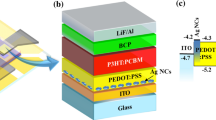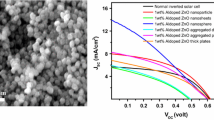Abstract
Plasmonic nanoparticles such as those of gold or silver have been recently investigated as a possible way to improve light absorption in thin film solar cells. Here, a simple method for the preparation of spherical plasmonic gold nanoparticles in the form of a colloidal solution is presented. The nanoparticle diameter is controlled in the range from several nm to tens of nm depending on the synthesis parameters with the size dispersion down to 14 %. The synthesis is based on thermal decomposition and reduction of the chloroauric acid in the presence of a stabilizing capping agent (surfactant) that is very slowly injected into the hot solvent. The surfactant prevents uncontrolled nanoparticle aggregation during the growth process. The nanoparticle size and shape depend on the type of the stabilizing agent. Surfactants with different lengths of the hydrocarbon chains such as Z-octa-9-decenylamine (oleylamine) with AgNO3 and polyvinylpyrrolidone with AgNO3 were used for the steric stabilization. Hydrodynamic diameter of the gold nanoparticles in the colloidal solution was determined by dynamic light scattering while the size of the nanoparticle metallic core was found by small-angle X-ray scattering. The UV-VIS-NIR spectrophotometer measurements revealed a plasmon resonance absorption in the 500–600 nm range. Self-assembled nanoparticle arrays on a silicon substrate were prepared by drop casting followed by spontaneous evaporation of the solvent and by a modified Langmuir-Blodgett deposition. The degree of perfection of the self-assembled arrays was analyzed by scanning electron microscopy and grazing-incidence small-angle X-ray scattering. Homogeneous close-packed hexagonal ordering of the nanoparticles stretching over large areas was evidenced. These results document the viability of the proposed nanoparticle synthesis for the preparation of high-quality plasmonic templates for thin film solar cells with enhanced power conversion efficiency, surface enhanced Raman scattering, and other applications.
Similar content being viewed by others
References
Chitu, L., Siffalovic, P., Majkova, E., Jergel, M., Vegso, K., Luby, S., Capek, I., Satka, A., Perlich, J., Timmann, A., Roth, S. V., Keckes, J., & Maier, G. A. (2010). Modified Langmuir-Blodgett deposition of nanoparticles — measurement of 2D to 3D ordered arrays. Measurement Science Review, 10, 162–154. DOI: 10.2478/v10048-010-0028-0.
Esumi, K., Sarashina, S., & Yoshimura, T. (2004). Synthesis of gold nanoparticles from an organometallic compound in supercritical carbon dioxide. Langmuir, 20, 5189–5191. DOI: 10.1021/la049415e.
Feng, X., Ma, H., Huang, S., Pan, W., Zhang, X., Tian, F., Gao, C., Cheng, Y., & Luo, J. (2006). Aqueous-organic phase-transfer of highly stable gold, silver, and platinum nanoparticles and new route for fabrication of gold nanofilms at the oil/water interface and on solid supports. The Journal of Physical Chemistry B, 110, 12311–12317. DOI: 10.1021/jp0609885.
Hussain, I., Graham, S., Wang, Z. X., Tan, B., Sherrington, D. C., Rannard, S. P., Cooper, A. I., & Brust, M. (2005). Size-controlled synthesis of near-monodisperse gold nanoparticles in the 1–4 nm range using polymeric stabilizers. Journal of the American Chemical Society, 127, 16398–16399. DOI: 10.1021/ja055321v.
Li, X. H., Li, Y. C., Tan, Y. W., Yang, C. H., & Li, Y. F. (2004). Self-Assembly of gold nanoparticles prepared with 3,4-ethylenedioxythiophene as reductant. The Journal of Physical Chemistry B, 108, 5192–5199. DOI: 10.1021/jp0356618.
Ma, L. N., Liu, D. J., & Wang, Z. X. (2010). Synthesis and applications of gold nanoparticle probes. Chinese Journal of Analytical Chemistry, 38, 1–7. DOI: 10.1016/s1872- 2040(09)60013-x.
Liu, Q., Guo, M. L., Nie, Z., Yuan, J. B., Tan, J., & Yao, S. Z. (2008). Spacer-mediated synthesis of size-controlled gold nanoparticles using geminis as ligands. Langmuir, 24, 1595–1599. DOI: 10.1021/la702978z.
Liu, Y. J., Hao, Q. Z., Smalley, J. S. T., Liou, J., Khoo, I. C., & Huang, T. J. (2010). A frequency-addressed plasmonic switch based on dual-frequency liquid crystals. Applied Physics Letters, 97, 091101. DOI: 10.1063/1.3483156.
Mastiholi, B. M., Tangod, V. B., & Raikar, U. S. (2013). Influence of metal nanoparticles on ADS560EI fluorescent laser dye. Optik — International Journal for Light and Electron Optics. 124, 261–264. DOI:10.1016/j.ijleo.2011.11.054.
Moon, S. Y., Sekino, T., Kusunose, T., & Tanaka, S. I. (2009). Simple one-step synthesis of water and organic media soluble gold nanoparticles with various shapes and sizes. Journal of Crystal Growth, 311, 651–656. DOI: 10.1016/j.jcrysgro.2008.09.085.
Nakamoto, M., Kashiwagi, Y., & Yamamoto, M. (2005). Synthesis and size regulation of gold nanoparticles by controlled thermolysis of ammonium gold(I) thiolate in the absence or presence of amines. Inorganica Chimica Acta, 358, 4229–4236. DOI:10.1016/j.ica.2005.03.037.
Raikar, U. S, Tangod, V. B., Mastiholi, B. M., & Fulari, V. J. (2011). Fluorescence quenching using plasmonic gold nanoparticles. Optics Communications, 284, 4761–4765. DOI:10.1016/j.optcom.2011.05.038.
Selvakannan, P., Mandal, S., Pasricha, R., & Sastry, M. (2004). Hydrophobic, organically dispersible gold nanoparticles of variable shape produced by the spontaneous reduction of aqueous chloroaurate ions by hexadecylaniline molecules. Journal of Colloid and Interface Science, 279, 124–131. DOI: 10.1016/j.jcis.2004.06.027.
Siffalovic, P., Vegso, K., Jergel, M., Majkova, E., Keckes, J., Maier, G. A., Cornejo, M., Ziberi, B., Frost, F., Hasse, B., & Wiesmann, J. (2010). Measurement of nanopatterned surfaces by real and reciprocal space techniques. Measurement Science Review, 10, 153–156. DOI: 10.2478/v10048-010-0027-1.
Wang, L., Wei, G., Guo, C. L., Sun, L. L., Sun, Y. J., Song, Y. G., Yang, T., & Li, Z. (2007). Photochemical synthesis and self-assembly of gold nanoparticles. Colloids and Surfaces A: Physicochemical and Engineering Aspects, 312, 148–153. DOI:10.1016/j.colsurfa.2007.06.043.
Wiesmann, J., Graf, J., Hoffmann, C., Hembd, A., Michaelsen, C., Yang, N., Cordes, H., He, B., Preckwinkel, U., & Erlacher, K. (2009). X-ray diffractometry with low power microfocus sources — new possibilities in the lab. Particle & Particle Systems Characterization, 26(3), 112–116. DOI: 10.1002/ppsc.200800052.
Author information
Authors and Affiliations
Corresponding author
Rights and permissions
About this article
Cite this article
Benkovičová, M., Végsö, K., Šiffalovič, P. et al. Preparation of sterically stabilized gold nanoparticles for plasmonic applications. Chem. Pap. 67, 1225–1230 (2013). https://doi.org/10.2478/s11696-013-0315-y
Received:
Revised:
Accepted:
Published:
Issue Date:
DOI: https://doi.org/10.2478/s11696-013-0315-y




